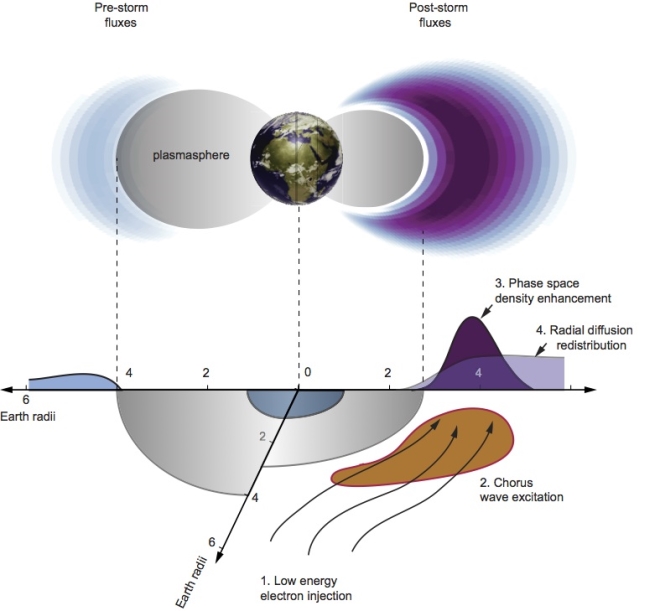December 18, 2013
New research published in the journal Nature resolves decades of scientific controversy over the origin of the extremely energetic particles known as ultra-relativistic electrons in the Earth's near-space environment and is likely to influence our understanding of planetary magnetospheres throughout the universe.
Discovering the processes that control the formation and ultimate loss of these electrons in the Van Allen radiation belts — the rings of highly charged particles that encircle the Earth at a range of about 1,000 to 50,000 kilometers above the planet's surface — is a primary science objective of the recently launched NASA Van Allen Probes mission. Understanding these mechanisms has important practical applications, because the enormous amounts of radiation trapped within the belts can pose a significant hazard to satellites and spacecraft, as well astronauts performing activities outside a craft.
Ultra-relativistic electrons in the Earth's outer radiation belt can exhibit pronounced variability in response to activity on the sun and changes in the solar wind, but the dominant physical mechanism responsible for radiation-belt electron acceleration has remained unresolved for decades. Two primary candidates for this acceleration have been "inward radial diffusive transport" and "local stochastic acceleration" by very low-frequency plasma waves.
In research published Dec. 19 in Nature, lead author Richard Thorne, a distinguished professor of atmospheric and oceanic sciences in the UCLA College of Letters and Science, and his colleagues report on high-resolution satellite measurements of high-energy electrons during a geomagnetic storm on Oct. 9, 2012, which they have numerically modeled using a newly developed data-driven global wave model.
Their analysis reveals that scattering by intense, natural very low–frequency radio waves known as "chorus" in the Earth's upper atmosphere is primarily responsible for the observed relativistic electron build-up.
The team's detailed modeling, together with previous observations of peaks in electron phase space density reported earlier this year by Geoff Reeves and colleagues in the journal Science, demonstrates the remarkable efficiency of natural wave acceleration in the Earth's near-space environment and shows that radial diffusion was not responsible for the observed acceleration during this storm, Thorne said.
Co-authors of the new research include Qianli Ma, a graduate student who works in Thorne's lab; Wen Li, Binbin Ni and Jacob Bortnik, researchers in Thorne's lab; and members of the science teams on the Van Allen Probes, including Harlan Spence of the University of New Hampshire (principal investigator for RBSP-ECT) and Craig Kletzing of the University of Iowa (principal investigator for EMFISIS).
The local wave-acceleration process is a "universal physical process" and should also be effective in the magnetospheres of Jupiter, Saturn and other magnetized plasma environments in the cosmos, Thorne said. He thinks the new results from the detailed analysis of Earth will influence future modeling of other planetary magnetospheres.
The Van Allen radiation belts were discovered in the Earth's upper atmosphere in 1958 by a team led by space scientist James Van Allen.
The new research was funded by the NASA, which launched the twin Van Allen probes in the summer of 2012.
For more on Thorne's research, visit his homepage.
UCLA is California's largest university, with an enrollment of more than 40,000 undergraduate and graduate students. The UCLA College of Letters and Science and the university's 11 professional schools feature renowned faculty and offer 337 degree programs and majors. UCLA is a national and international leader in the breadth and quality of its academic, research, health care, cultural, continuing education and athletic programs. Seven alumni and six faculty have been awarded the Nobel Prize.















